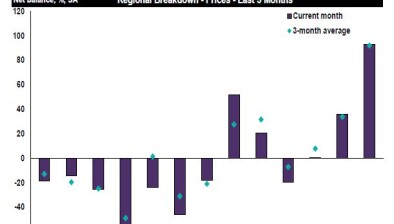RICS reiterates call for new Amberfield land classification
A new land classification of Amberfield would reduce costs for developers and enable SMEs and self/custom builders to generate homes at speed, according to the Royal Institution of Chartered Surveyors (RICS).

Hew Edgar
Amberfield is land that is ready to go, for example brownfield land that does not require works.
RICS said the classification is identified by local authorities and communities as “favourable for development in line with local needs”.
The call comes as results from the Q2 2020 RICS Construction and Infrastructure market survey for Scotland revealed a predictable contraction in output, as workloads decline across all sectors. Anecdotal commentary from respondents also suggests that labour shortages, some due to furlough, alongside other issues, are impacting projects.
In Q2 2020, 43% more contributors in Scotland reported a decline rather than rise (net balance) in workloads, as they slipped across all areas covered by the survey. This includes 13% more respondents reporting a fall in private housing workloads, the first fall since 2016. A solid decline in output was also reported across public housing and the other public works categories.
Meanwhile, there was also a decline in infrastructure workloads with 53% more contributors in Scotland reporting a fall (as opposed to a rise) during Q2, the biggest decline since 2009.
Hew Edgar, RICS head of government relations, said: “Historically, the Scottish Government has recognised the beneficial impact of fiscal stimuli for construction and infrastructure, and its recognition of the sectors’ contribution to kickstarting the post-COVID recovery and the wider economy is welcome. In addition to long term capital, there are non-financial initiatives and schemes that the government can make to boost construction and infrastructure activity, such as support for innovation, and continued streamlining of planning as the sector battles COVID.
“While the survey shows the inevitable impacts of COVID, it also cites barriers to construction that could be removed with a bit more impetus and innovation from government.
“RICS’ past suggestion of a new land classification of Amberfield is ready to go land, identified by local authorities and communities as favourable for development in line with local needs. It would reduce costs for developers including local authorities and enable SMEs and self/custom builders to generate homes at speed. Lifting this particular barrier could even go some way to representing that mythical silver bullet as it would address multiple concerns cited in the survey including planning delays and the drop in housebuilding, as well as spawning activity in the supply chain and thereby easing materials shortages.”
He added: “We’d also like to see further support for modular housing, which has the potential to be a star contributor to activity, with the added bonus of positively impacting green targets and product quality.”
Looking ahead, 17% more Scotland-based surveyors expect workloads to decline rather than rise (net balance) over the next year. It is a similar story with regard to hiring intentions and profit margins with respondents also expecting these to be lower in 12 months. Net balances of -33% and -52% were reported respectively.
Neil MacDougall MRICS of Diamond & Co in Glasgow said: “The practical implications in the event of redundancies upon completion of the furlough scheme may see firms understaffed with skill shortages in some areas.”
Simon Rubinsohn, RICS chief economist, added: “A weak Q2 survey was only to be expected given the impact of the pandemic on the construction sector. Slightly more ominously, forward looking indicators are also still fairly cautious, apart from the infrastructure sector which should benefit from recent government initiatives.”









